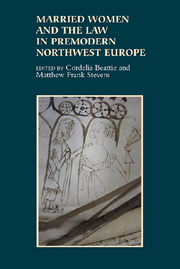Book contents
- Frontmatter
- Contents
- Figures and Tables
- Contributors
- Introduction: Uncovering Married Women
- 1 Inheritance, Property and Marriage in Medieval Norway
- 2 Spousal Disputes, the Marital Property System, and the Law in Later Medieval Sweden
- 3 When Two Worlds Collide: Marriage and the Law in Medieval Ireland
- 4 Married Women, Crime and the Courts in Late Medieval Wales
- 5 Peasant Women, Agency and Status in Mid-Thirteenth- to Late Fourteenth-Century England: Some Reconsiderations
- 6 London's Married Women, Debt Litigation and Coverture in the Court of Common Pleas
- 7 Married Women, Contracts and Coverture in Late Medieval England
- 8 Property, Family and Partnership: Married Women and Legal Capability in Late Medieval Ghent
- 9 ‘For His Interest’? Women, Debt and Coverture in Early Modern Scotland
- 10 The Worth of Married Women in the English Church Courts, c.1550–1730
- 11 Married Women, Work and the Law: Evidence from Early Modern Germany
- Index
8 - Property, Family and Partnership: Married Women and Legal Capability in Late Medieval Ghent
Published online by Cambridge University Press: 05 July 2013
- Frontmatter
- Contents
- Figures and Tables
- Contributors
- Introduction: Uncovering Married Women
- 1 Inheritance, Property and Marriage in Medieval Norway
- 2 Spousal Disputes, the Marital Property System, and the Law in Later Medieval Sweden
- 3 When Two Worlds Collide: Marriage and the Law in Medieval Ireland
- 4 Married Women, Crime and the Courts in Late Medieval Wales
- 5 Peasant Women, Agency and Status in Mid-Thirteenth- to Late Fourteenth-Century England: Some Reconsiderations
- 6 London's Married Women, Debt Litigation and Coverture in the Court of Common Pleas
- 7 Married Women, Contracts and Coverture in Late Medieval England
- 8 Property, Family and Partnership: Married Women and Legal Capability in Late Medieval Ghent
- 9 ‘For His Interest’? Women, Debt and Coverture in Early Modern Scotland
- 10 The Worth of Married Women in the English Church Courts, c.1550–1730
- 11 Married Women, Work and the Law: Evidence from Early Modern Germany
- Index
Summary
Three days after Christmas, 1357, Pernéele, the wife of Willem Bailluz, went to the court of the aldermen of the Keure in Ghent to perform a legal act - paying part of a debt owed by her daughter. Perneele was the surety, rather like a modern co-signer, for a debt that her daughter had contracted. When her daughter could not pay the debt, Perneele became legally responsible for paying the creditor. While the brief act recorded in the aldermen's register does not explain why Perneele acted as a surety for her daughter, there are two likely scenarios. The most likely is that Perneele was a remarried widow, and she had legally obligated herself as a surety for her daughter during her widowhood. A second possibility is that Perneele was married at the time that she obligated herself alone, without her husband, to be her daughter's surety. Since Perneele owned personal property coming from her family of origin, she could pledge her property, rather than the couple's community property, to secure a debt. It is not likely that the clerk omitted Willem's name if he was a joint surety along with his wife, because the aldermen's clerks typically wrote down exactly who the debtor and surety or sureties were, and the clerks noted if one spouse paid for another. But this clerk did not explain why a married woman could be legally responsible for a debt, or act legally without her husband.
- Type
- Chapter
- Information
- Married Women and the Law in Premodern Northwest Europe , pp. 155 - 172Publisher: Boydell & BrewerPrint publication year: 2013

